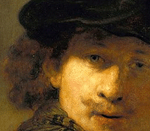
"The Prophecy of the Destruction of the Temple"
Jacques Joseph Tissot (15 October 1836 – 8 August 1902), better known as James Tissot was a French painter, illustrator, and caricaturist whose work incorporates elements of realism, early Impressionism, and academic art. In mid life he gained success among British audiences and was lauded for his photorealistic, narrative style of art. in 1885 Tissot experienced a religious vision at the Church of St. Sulpice, leading him to revive his Catholic faith and spend the remainder of his life making paintings about biblical events. Moving away from the Impressionists' and Post-Impressionists' intent to create art that reflected a changing, modern world, Tissot returned to traditional, representational styles and narratives in his watercolors.
His series of 365 gouache illustrations showing the life of Christ were shown to critical acclaim and enthusiastic audiences in Paris (1894–1895), London (1896) and New York (1898–1899), before being bought by the Brooklyn Museum in 1900.
This painting depicts that having departed from the Temple for the final time, Jesus sits with a small group of his disciples: Peter, James, Andrew, and John the Evangelist. Against the backdrop of the Temple complex and the thick, fortified walls of Jerusalem, he prophesies the destruction of the Temple and its splendor—an event understood by the group as marking the end of times.
Tissot spent the last years of his life working on paintings of subjects from the Old Testament.